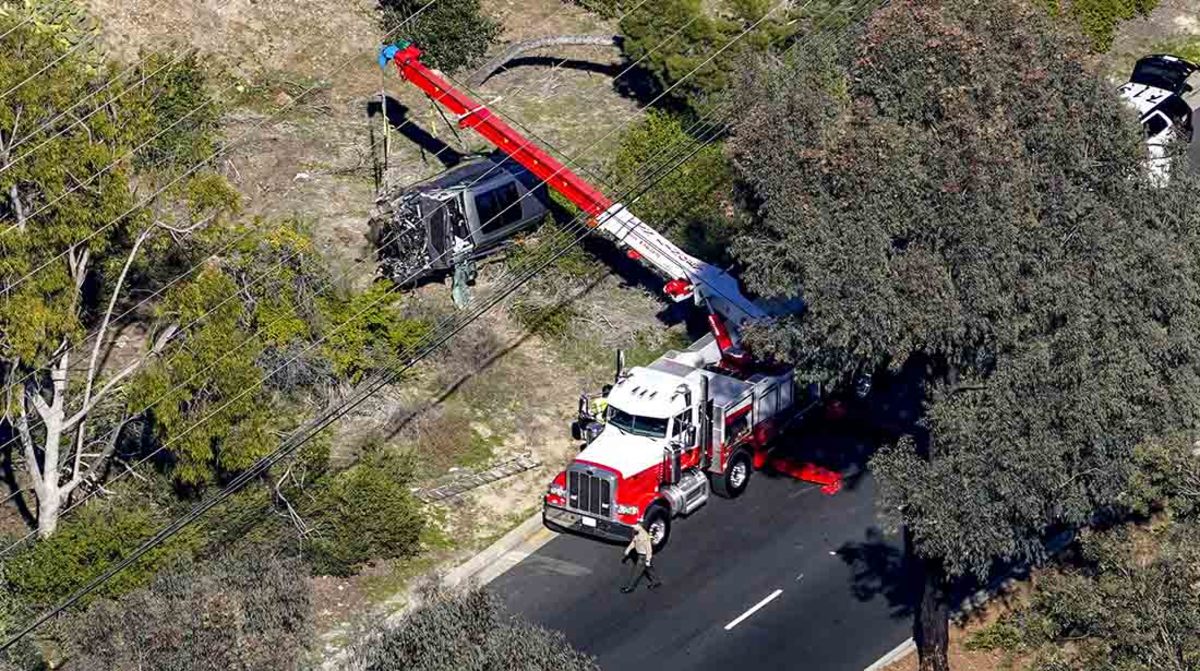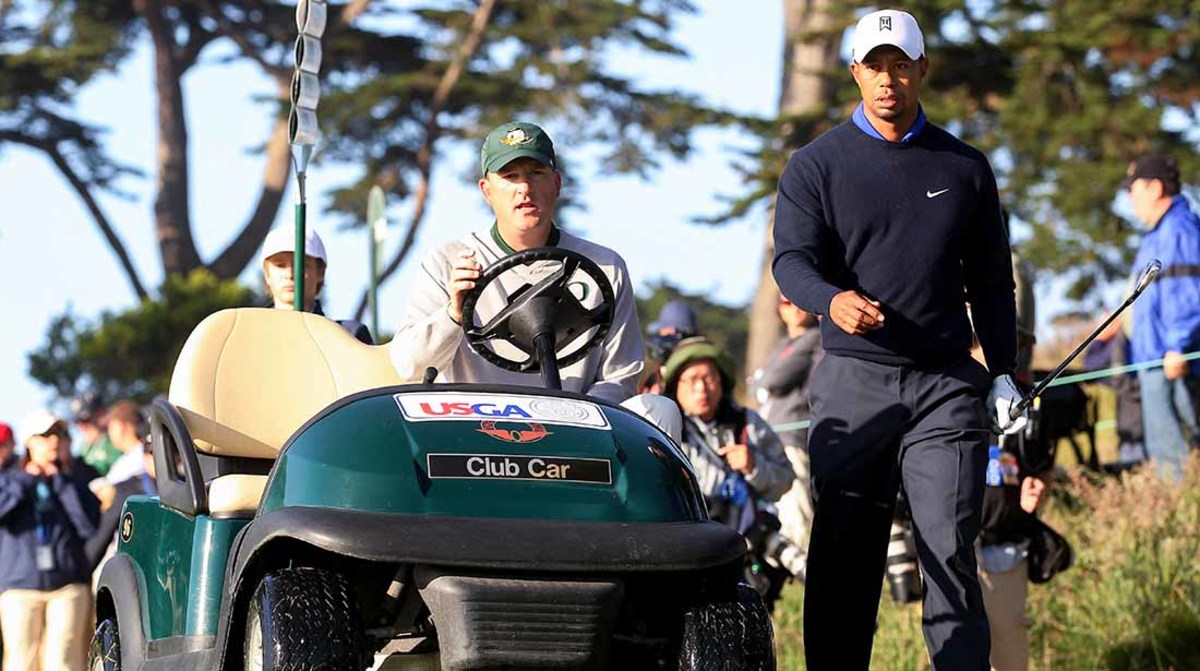Casey Martin Knows What Tiger Woods Faces. He Can’t Wait to Watch
Tiger Woods returns to public golf this week at the PNC Championship, playing with his 12-year-old son, Charlie, and—if he chooses—riding in a cart.
“Is he really?” Casey Martin asks.
This is rich, isn’t it? Twenty years ago, Martin sued the PGA Tour for the right to use a cart during competition. He was born with a circulation disorder in his right leg called Klippel-Trenaunay-Weber Syndrome, and he could do everything an elite golfer could do, except walk. That was excruciating. The Tour argued that walking was an essential part of golf. So did Jack Nicklaus. So did Martin’s old Stanford teammate and friend Tiger Woods.
“I’m gonna give him crap,” Martin says. “I’m going to text him: Hey, I’m pumped you’re playing, but I want some kickbacks if you take a cart.”

Martin laughs. He is serious about the text, but he wants to be clear about his intent. He loves Tiger. He always has. Their disagreement a generation ago was never personal. Martin, at 49, wants to needle Tiger, at 45, because that’s what friends do—and if anybody understands that, it’s Tiger Woods.
Woods has many closer friends. But there is nobody who understands this incarnation of Tiger Woods the way that Martin does. Martin has known Woods for most of Tiger’s life, and he knows what it’s like to compete on the PGA Tour with a right leg that is close to useless. Martin understands the challenge ahead for Woods—but, for a variety of reasons, he believes Tiger can meet it.
Woods said recently that a right-leg amputation was “on the table” for him this year. Martin knows all about that, too. Two years ago, he broke his right leg when he slipped in front of his house, and there was no real chance that it would heal properly. He tried everything and finally decided his best chance at a normal life was amputation, just above his knee.
Martin’s doctors in Eugene, Ore., where he coaches the University of Oregon’s golf team, told him that the procedure was too risky for them. So Martin met with a surgeon at the Mayo Clinic.
“The guy looked at me and said, ‘I can do this,’” Martin recalls. “‘But I'm going to be nervous.’”
Martin appreciated the honesty. He decided to go for it. As he awaited surgery in October, one of the last texts he received was from Tiger.
“He basically said: Man, I know you've been through a ton,” Martin says. “He referenced God, in the sense of, You can handle this. He said I'm one tough MF… Love you, dude. Right before I'm going into surgery, that text meant a lot.”
Twice, as a younger man, Martin played U.S. Open practice rounds with Woods. He was astounded by both the size and the passion of the galleries. There had never really been anything like that in golf. Back then, Martin wondered what it was like to be Tiger Woods. Now Tiger Woods is finding out what it’s like to be Casey Martin.

Start with the swing. Tiger has always been a golf dork, after all. No detail is too small, no nuance too subtle, no conversation about grips or grass strains or ball flight too boring. After Woods emerged from that frightening one-car accident in Los Angeles with comminuted open fractures in the tibia and fibula of his right leg, and after he said that the pain was worse than anything he had experienced in a career filled with injuries, Casey Martin saw hope in one word: right leg.
“Left leg, he’s done,” Martin says. “Left leg, he’d never play golf again at a high level, because you’ve gotta drive into your left side. But right leg? You can do it.”
Martin knows. He made it all the way to the PGA Tour with a bum right leg. “I didn't use my right leg much,” Martin says. “I just bumped on it. If he can just put a little pressure on it—which I’m sure he can, because he's walking—he'll be shockingly better than you think.”
Martin heard Woods say that he can play “hit-and-giggle golf,” which is all that this PNC Championship is, and Martin says, “I think he's just slow-playing everybody.” Martin believes Tiger can do much better. His only question is whether Tiger can regain distance.
“You can't play on Tour if you can't drive it 300 [yards] with moderate accuracy,” Martin says. “If he hits 250 and can't play, he ain't gonna play. He’s gonna shut it down. But I don’t think that’s [the reality]. I mean, I can hang out on my left side and swing my arms and hit it 280. And I'm not Tiger.
“I've got pictures of him pivoting, which are ridiculous, when he was a kid. You don't need to do that. Gumby doesn't last forever. … I've worked on it for 49 years—I can tell him exactly what to do. Just stay left-sided and swing your arms as fast as you can, and he'll be good.”
In his last three full years on Tour, Woods averaged 303.6, 296.8 and 299.4 yards off the tee. But those were averages. He needs to be able to hit it longer than that at times.
“He's probably got to work [on] the driver and how to build pressure into his right side and be dynamic that way,” Martin says. “And that will be the real tell on whether he can play. But for hitting nine-irons and eight-irons, he's the best in the world at it. And this will not affect him.”
Woods has two advantages over any other golfer who might try to come back from such horrific injuries. One is that nobody in history, including Nicklaus, reached the heights that Woods did. The other: He has rebuilt his swing many times before, first because he’s a restless perfectionist, and later because his body could no longer do what it once did. If there is a swing that works for Tiger Woods, Tiger Woods will find that swing.

Casey Martin emerged from surgery this fall with more of his right leg than he anticipated. “The first thing I did is check my leg,” Martin says. “I’m like, Well, I’ve got a lot of it.”
This was supposed to be the end of a brutal stretch for him, but it was also the start of a more brutal one. Doctors had warned him about phantom pain, a sensation that the amputated part of his leg was still hurting. The reality was like nothing Martin had ever experienced.
“I just figured I'd have some pain that I used to have, and I'd deal with it—but it's not like that at all,” Martin says. “It's electric. It's like my lower-right leg, which is gone, is connected to a freaking Taser. And it just goes up and down [my leg] all day, giving me these really intense shocks.”
Woods knows about intense post-surgical pain; that pain may have helped lead him toward rehabilitation for prescription-drug abuse. Martin has taken opioids after surgeries; he just vowed not to stick with them long-term. But the pain has been debilitating: “I could not sleep at all. You'd lay down and it's like you're being electrocuted.”
He needed two follow-up surgeries after the amputation. It is quite possible that, even as Woods had his worst year, Martin had an even worse one. This is a long way of saying that Casey Martin has many more important things on his mind these days than an old friend playing in a silly-season event 3,000 miles away.
But when Woods tees it up in Orlando this week, Martin will be watching. Martin says that he and Woods are “just desperately trying to keep our legs and walk,” but the connection he feels goes far beyond that, and it goes beyond his personal relationship with Woods. He feels the way millions of Tiger Woods fans feel. Nobody ever did what Tiger did before. Who knows what he might do next?
“I don't know exactly what he's dealing with,” Martin says. “But my gut says, if he's able to play at a high level, if he can taste it again … he’s not going to be on a celebrity circuit. The thing is the speed, and just being dynamic off the tee—and that's [what] I struggled with. I felt like I was a good driver. But if my leg hurt bad, I was in bad shape trying to hit it hard.”

Martin knows better than just about anybody on the planet how hard this will be for Tiger. He might know even better than Tiger. And still, he believes.
“Tiger is such a physical freak that if he can just walk enough, he'll find a way,” Martin says. “I think people will be surprised at how good he hits the ball.”
There are so many unknowns here. How far can Woods hit it? Can he still manipulate the ball like he did? Can his body handle a full slate of practice, physical therapy, warmups and four straight rounds of golf on championship-quality tracks? Will he request an exemption to use a cart in real tournaments—something he derided John Daly for doing as recently as 2019? Then there is the question Woods entertained recently: How badly does he even want to reach the top again?
These questions are part of the allure, because they are subsets of the larger question that has defined Woods’s entire career: What will Tiger do next?
“We’re gonna see it,” Martin says. “I can’t wait to watch. Get in your cart. Hobble around. Good luck!”
He laughs. He’s joking again. Tiger has closer friends and so many other fans, but he doesn’t have any friend or fan quite like Casey Martin. It’s been a hellish year for both of them. They will look for a dose of joy in the same place.
“I'm going to be glued to that show,” Martin says.
• Tom Brady Wins 2021 SI Sportsperson of the Year Award
• How the Supply-Chain Crisis Led to a Pylon Shortage
• A Quarterback Evolution and a Coaching Revolution
• The NFL’s First Real Foray Overseas, 30 Years Later
